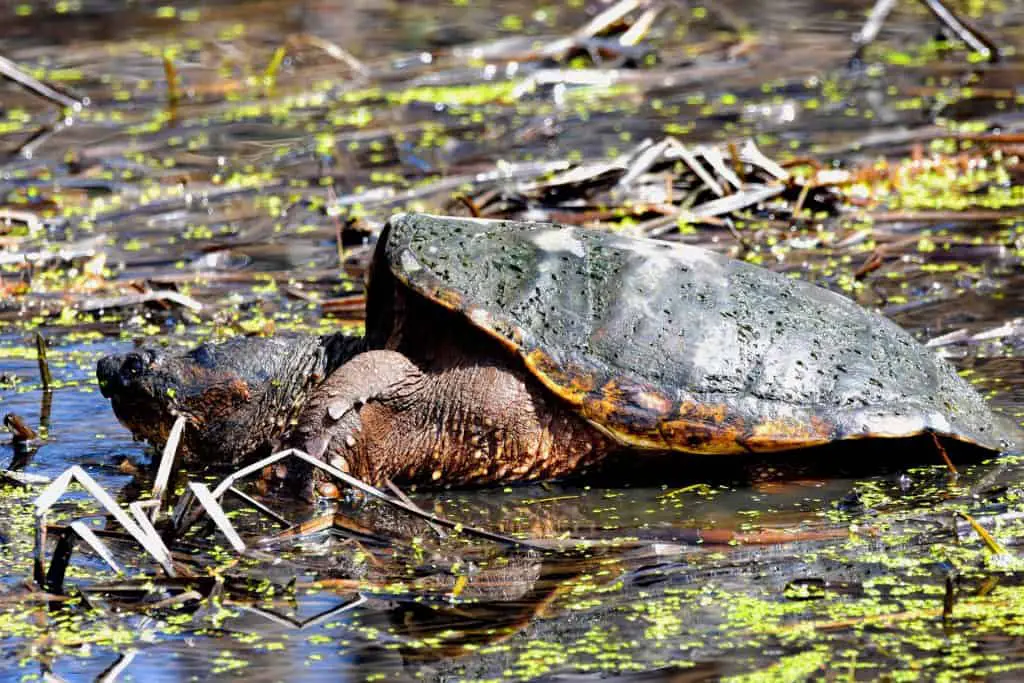You’re swimming in a cool lake on a sunny day when you spot the unmistakable shape of a snapper turtle. You know how aggressive they can be, and you’re not sure what to do. Do you bravely swim closer to get a better look, or do you swiftly move away, hoping the reptile doesn’t notice you?
so you as your self should I Swim near this snapping turtle or not? Generally, it’s not wise to swim near a snapping turtle as they can get defensive and aggressive if they feel threatened. It’s best to carefully observe them from a distance and avoid abrupt movements or making loud noises that might startle them.
Swimming near a snapping turtle can be dangerous as they are known to be aggressive and have powerful bites. Additionally, the visibility when swimming near them is often limited, making it harder to stay aware of their presence and movement. Moreover, interacting with a snapping turtle may lead to potential interactions with other nearby wildlife and disrupt their natural habitats. Therefore, it is best to avoid swimming near a snapping turtle for safety’s sake.
An Overview of Snapping Turtle

Snapping turtles are large aquatic reptiles that belong to the family Chelydridae, and they can be found in ponds and slow-moving rivers throughout much of North America. They have dark brown or black shells which often have a yellow or greenish tint.
The carapace of a snapping turtle can reach up to 18 inches, and they have long, thick necks and powerful jaws.
Signs and behaviors that indicate a snapping turtle might be aggressive or feeling threatened Snapping turtles are usually peaceful animals but they can get defensive when they feel threatened. If a snapper is disturbed, it will likely tuck its limbs and head inside its shell, start hissing or strike out with its jaws.
Signs Indicate a Snapping Turtle Might Be Aggressive or Feeling Threatened.
When a snapping turtle detects something it deems as threatening, its defense mechanisms are triggered and various behaviors may ensue. Hissing, lunging, biting – these are all likely reactions to the presence of a potential predator. The use of their tail as an offensive mechanism is another warning sign they may display.
In addition to this, retreating into their shell for safety measures is also common in times like these. As such, you must remain watchful when approaching or interacting with one of these reptiles; understanding their behavior can be paramount for your own protection!
1. Signs of Aggression in Snapping Turtles
When a snapping turtle senses danger or aggression, it might exhibit certain behaviors to signal its warning – hissing, lunging, and even biting. Its tail is also used as an effective tool of protection against perceived predators; all these signs can’t be overlooked since they are indications that the turtle is trying to protect itself. Do not underestimate this creature’s power!
2. Hissing and Lunging
One of the most prominent signs that a snapping turtle might be feeling angry or scared is if it begins to hiss or lunge at potential threats in its environment. This behavior can also serve as a warning sign for people to stay away from the snapping turtle, lest they incur its wrath.
3. Biting and Use of Tail as Weapon
In addition to hissing and lunging, another sure-fire sign that a snapping turtle may be feeling threatened or aggressive is if it attempts to bite anything that comes too close to it or uses its tail as a weapon in order to defend itself from danger.
4. Retreating Into Shells for Protection
Snapping turtles will also retreat into their shells for protection against potential predators, either because they feel threatened or because they want to surprise their attackers with quick strikes once they come out of their shells again. you should always demonstrate respect towards this behavior and do your best to avoid it.
5. Staying Alert and Aware of Safety:
When encountering snapping turtles in the wild it is important to stay alert and aware at all times so that you can spot any signs of aggression before they become too dangerous or violent towards you or anyone else around them.
Moreover, it is important to remember that these animals are wild and should not be interacted with or harassed.
Safety Tips for Swimming Near a Snapping Turtle
Snapping turtles can be dangerous when approached too closely, but with the right knowledge and caution, they can be admired from a safe distance. It is important to be able to identify these animals from a distance so that one can remain alert and aware of their presence.
It is also important to understand the behaviors that a snapping turtle might display when feeling threatened or aggressive, such as hissing, biting, lunging, etc. Respect for the animal’s space should always be given and unnecessary conflicts must be avoided.
it is essential to keep a safe distance from the snapping turtle—never approach too closely—to remain safe from potential danger.
below are a few crucial points that you have to consider if you decide to swim near a snapping turtle.
1. Identifying a Snapping Turtle from a Distance
If you are swimming in an area with snapping turtles, it is important to know how to spot them from a distance so that you can be aware of their presence and act accordingly. Signs that may indicate the presence of snapping turtles include visible shell plates, uncharacteristic movement along the shoreline, or even loud splashing as they dive into the water. Paying attention to these warning signs can help you stay safe while swimming near a snapping turtle.
2. Understanding the Behaviors of a Snapping Turtle
When observing a snapping turtle in its natural habitat it is important to understand the behaviors that it tends to display when feeling threatened or aggressive. These can include hissing, lunging, biting, and using its tail as a weapon for defense purposes.
Noting these behaviors ahead of time will help you remain alert and informed when approaching them in order to minimize potential conflicts and remain safe yourself.
3. Having Respect for a Snapping Turtle’s Space
A key factor in staying safe around snapping turtles is simply respecting their space and not encroaching on their personal territory unnecessarily.
Creating boundaries between you and the Snapping Turtle helps avoid any unnecessary conflict or distress being caused by approaching too close or too quickly without an understanding of the animal’s needs or feelings.
4. Staying Alert and Avoiding Potential Conflicts
It is important to always stay alert when around wildlife, especially when approaching snapping turtles due to their tendency towards aggression if they feel threatened or scared by your presence.
Acting carefully and deliberately will help keep you safe from any potential conflicts or confrontations that may arise due to a lack of awareness.
5. Keeping Your Distance To Remain Safe
one of the best practices when swimming near snapping turtles is simply keeping your distance at all times; never attempt to approach one too closely as it could result in injury either on your part or theirs depending on their level of aggression at any given moment in time.
Conclusion
Swimming near a snapping turtle can be an exciting experience as long as you are aware of the snapping turtle’s characteristics, behavior, and safety tips. It is important to remember that these animals are wild and should not be interacted with or harassed.
It is essential to keep a safe distance from the snapping turtle—never approach too closely—to remain safe from potential danger. Following these guidelines will help ensure that you and the snapping turtle remain safe and respected at all times.
Read More about Snapping Turtles




Leave a Reply